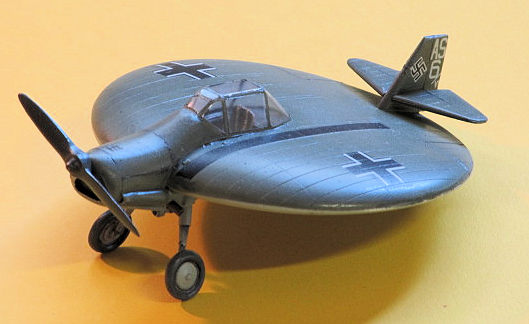
| KIT #: | 72014 |
| PRICE: | $10.00 second hand |
| DECALS: | One option |
| REVIEWER: | Ryan Grosswiler |
| NOTES: | Why not? Short run kit. |

| HISTORY |
There's really not much to the story of this funny little airplane, and what is known does in fact seem so much like satirical fiction that if it weren't for period photos (some faked, however) and a consistency to the accounts from various sources I would've thought it was a net-hoax.
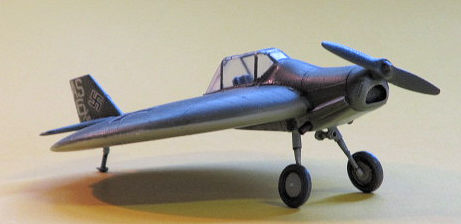 It runs something like this: farmer/aeromodeller Arthur Sack brought a model of
his vision of the Ultimate Airplane to a 1938 model competition in Germany. The
model didn't, in fact, fly well, but while struggling with it he ran into no
less a figure than Great War fighter ace turned Luftwaffe Direktor-General Ernst
Udet (who, as an aside, bore an uncanny resemblance to my cousin Bob in some
pictures). Udet was sufficiently fascinated with Sack's circular-wing
contraption to be able to secure the farmer some support and funding, and
between the pressing duties of agriculture and animal husbandry Sack developed
his unspecified concept through several more progressively larger models (all
free-flight, for this was long before the advent of proportional radio
control).
It runs something like this: farmer/aeromodeller Arthur Sack brought a model of
his vision of the Ultimate Airplane to a 1938 model competition in Germany. The
model didn't, in fact, fly well, but while struggling with it he ran into no
less a figure than Great War fighter ace turned Luftwaffe Direktor-General Ernst
Udet (who, as an aside, bore an uncanny resemblance to my cousin Bob in some
pictures). Udet was sufficiently fascinated with Sack's circular-wing
contraption to be able to secure the farmer some support and funding, and
between the pressing duties of agriculture and animal husbandry Sack developed
his unspecified concept through several more progressively larger models (all
free-flight, for this was long before the advent of proportional radio
control).
Fast forward to 1944. Sack had moved his work to the Luftwaffe airfield at
Brandis, finally incorporating his body of data into a full-sized aircraft: the
manned AS-6 modeled here. This proof-of-concept prototype was assembled with the
help of bemused Luftwaffe ground crew at the hangars plus
leftover Messerschmitt bits from the base scrapyard. A series of pilots
(including at least one from the Me-163 Komet rocket-plane unit stationed there;
no cowards they) then attempted to fly the AS-6 throughout the spring o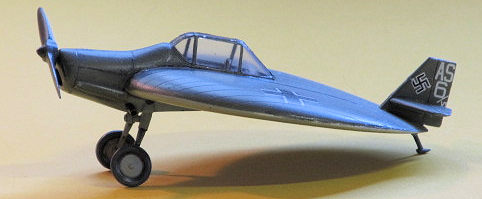 f 1944.
Sources vary as to whether the strange little airplane actually defied gravity
and sustained any flight. What they do agree on is that if it did so it never
left a straight line, at least under any control, and attempting to get it out
of ground effect put the fear of God into all who dared. It ended up with a bent
landing gear leg after several such attempts and by varying accounts was either
put out of its misery at the end of the year by strafing Allied fighter aircraft
by that time swarming over Germany proper and/or was broken up for firewood to
warm the freezing/starving locals. Sack slipped back into history.
f 1944.
Sources vary as to whether the strange little airplane actually defied gravity
and sustained any flight. What they do agree on is that if it did so it never
left a straight line, at least under any control, and attempting to get it out
of ground effect put the fear of God into all who dared. It ended up with a bent
landing gear leg after several such attempts and by varying accounts was either
put out of its misery at the end of the year by strafing Allied fighter aircraft
by that time swarming over Germany proper and/or was broken up for firewood to
warm the freezing/starving locals. Sack slipped back into history.
Remove him, however, from the cause he dubiously served for just a moment. We as
humans like to ease our own insecurities by mocking and dismissing folks like
Arthur Sack. Leaving the discussion there, however, would be a mistake: most
truly revolutionary advances originate with a) someone's crazy idea, and b)
their courage in getting out there to prove it works. The bullet points of the Direktor-general's
chit-chat with the dreaming farmer/model airplane buff in 1938 are probably lost
to history, but the fact that circular-wing aircraft experiments were successful
elsewhere (think: Vought V-173) in
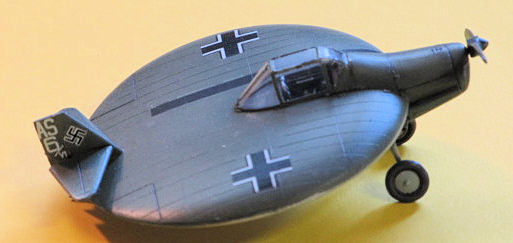 producing aircraft with astonishing
maneuverability at low speed indicates that Sack maybe made mistakes only in the
details. With a little tweaking the AS-6 might have flown, and flown very well.
producing aircraft with astonishing
maneuverability at low speed indicates that Sack maybe made mistakes only in the
details. With a little tweaking the AS-6 might have flown, and flown very well.
Herein lies some discussion on the mysteries of the human consciousness and its
mostly-unused capabilities. As we live in a civilization which has lost the
value of truly original thinking and whose headline-grabbing technical advances
lie increasingly in the purpose of keeping us vacantly preoccupied (think about
how excited everyone gets about the newest iPhone, or the latest incarnation
of World of Warcraft), you will concurrently notice less and less actual
innovation as time goes by.
Message? All at once this little disk-airplane is both pathetic and awesome, in the general spirit of guys who attach large numbers of helium balloons to lawn chairs and go pissing off the FAA.
| THE KIT |
The box art is dated 1998. A single small low-pressure-injected sprue with 19 parts, all in Special Hobby's characteristic shiny light grey plastic from this company's products around the turn of the millennium. A little baggie of resin interior bits, a vac canopy, and decals for the one aircraft complete the package. A close examination of the main parts reveals that Special Hobby did not depict just a simple rounded disk, but commendably captured the subtle dihedral and airfoil section which are just barely visible in the few surviving photos of the prototype.
| CONSTRUCTION |
I started by joining the disk halves after first spending a few minutes with a
Permagrit sander to thin up the trailing edges a bit. The stump-fuselage halves
were then test fit to this subassembly and after a little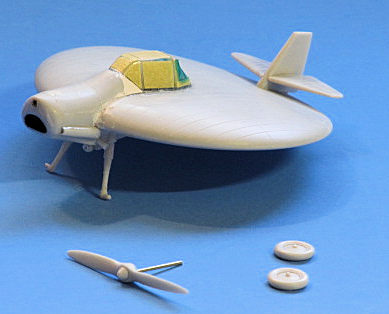 more sanding were
joined. The resin cockpit, cowl front, and canopy could then be checked for fit.
These were then all glued in place, with the additions of my usual
telescoped-brass prop shaft and some filler required where the fuselage met the
wing-disk and canopy front being about the only tasks which held things up.
more sanding were
joined. The resin cockpit, cowl front, and canopy could then be checked for fit.
These were then all glued in place, with the additions of my usual
telescoped-brass prop shaft and some filler required where the fuselage met the
wing-disk and canopy front being about the only tasks which held things up.
Before being closed under the canopy, the cockpit was given a coat of RLM 66-ish dark gray, then the seatbelts picked out in off-white followed by a quick dry-brush of silver over the whole cockpit tub. After the canopy was attached and masked the landing gear legs, exhaust pipes, and tail surfaces were glued on. I did bore out some 1/16" holes on the fuselage bottom for the landing gear legs to have more secure seating than the butt-joint the kit provides. In less than a cumulative 2 hours--greased lightning, baby--of pleasant work I had the model ready for primer coat. (By contrast, I'm up to 300+ hours on the Aviation Usk vac-form B-32 also in residence on my bench and it's still about 10 hours from first paint!)
| COLORS & MARKINGS |
As I wedged this project in with my ICM Fw-189 which I was building and
finishing in parallel, and already spraying RLM colors 65 Hellblau and 71 Du nkelgrun, I
could just slip this little model in as a 'rider'. After a white primer coat and
simple pre-shading, I sprayed the bottom grey, flipped it over, and sprayed the
top green. Bingo-bango-bongo--in and out of the paint shop in five extra
minutes of work!
nkelgrun, I
could just slip this little model in as a 'rider'. After a white primer coat and
simple pre-shading, I sprayed the bottom grey, flipped it over, and sprayed the
top green. Bingo-bango-bongo--in and out of the paint shop in five extra
minutes of work!
Decals were vintage Propagteam, and were predictably thin and excellent. Just
get them into position quickly! Swastikas were out of register so I overlaid
them with a couple from an old Superscale sheet. I didn't weather the model,
other than drybrushing a little silver to emphasize conspicuous edges and panels
which would have been frequently removed on a prototype being readied for test.
All this was locked under a coat of old Aeromaster semi-gloss enamel.
| CONCLUSIONS |
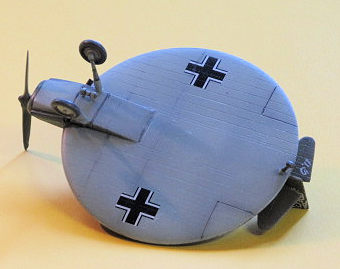 Silly, simple, satisfying. I think I have a total of 2.5 hours in this, start to
finish. A great introduction to short-run injection kits and a head-scratching
addition to my lineup. Highly recommended.
Silly, simple, satisfying. I think I have a total of 2.5 hours in this, start to
finish. A great introduction to short-run injection kits and a head-scratching
addition to my lineup. Highly recommended.
Thanks to my sister, who is a best selling author, to have the presence of mind while out on a "research" trip to spot a pile of still-sealed old kits for sale at an antiques yard and picking out for me what she thought were the two weirdest. The other was the Azur Loire 130--stay tuned!
| REFERENCES |
Nowhere in my not-insubstantial aviation library is to be found any reference, direct or otherwise, to this experimental aviation footnote. All I learned about it was on the Internet. And if it's on the Internet it must be true!
3 July 2017
Copyright ModelingMadness.com
If you would like your product reviewed fairly and
fairly quickly, please
contact
the editor or see other details in the
Note to
Contributors. Back to the Main Page
Back to the Review
Index Page
Back to the Previews Index Page